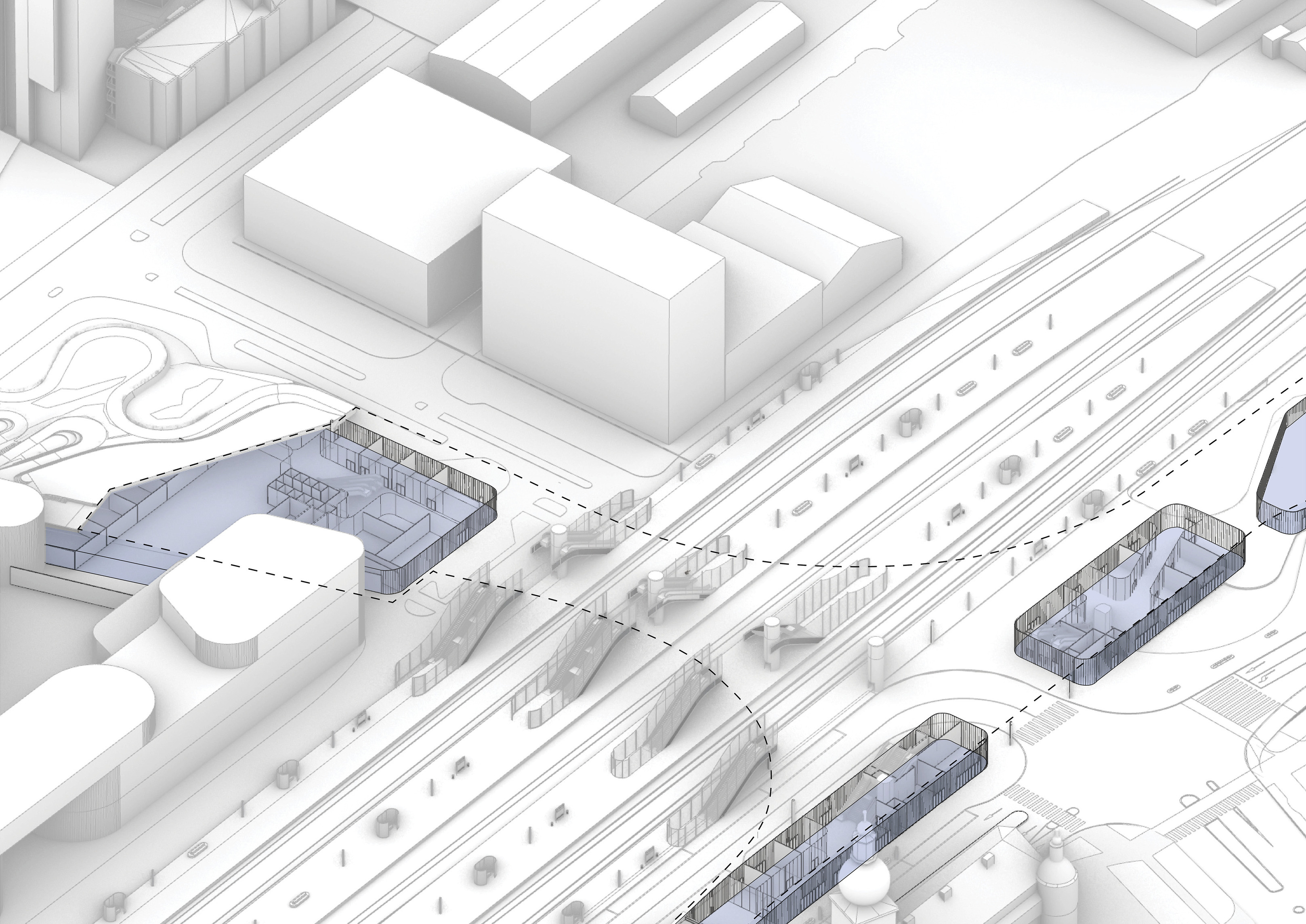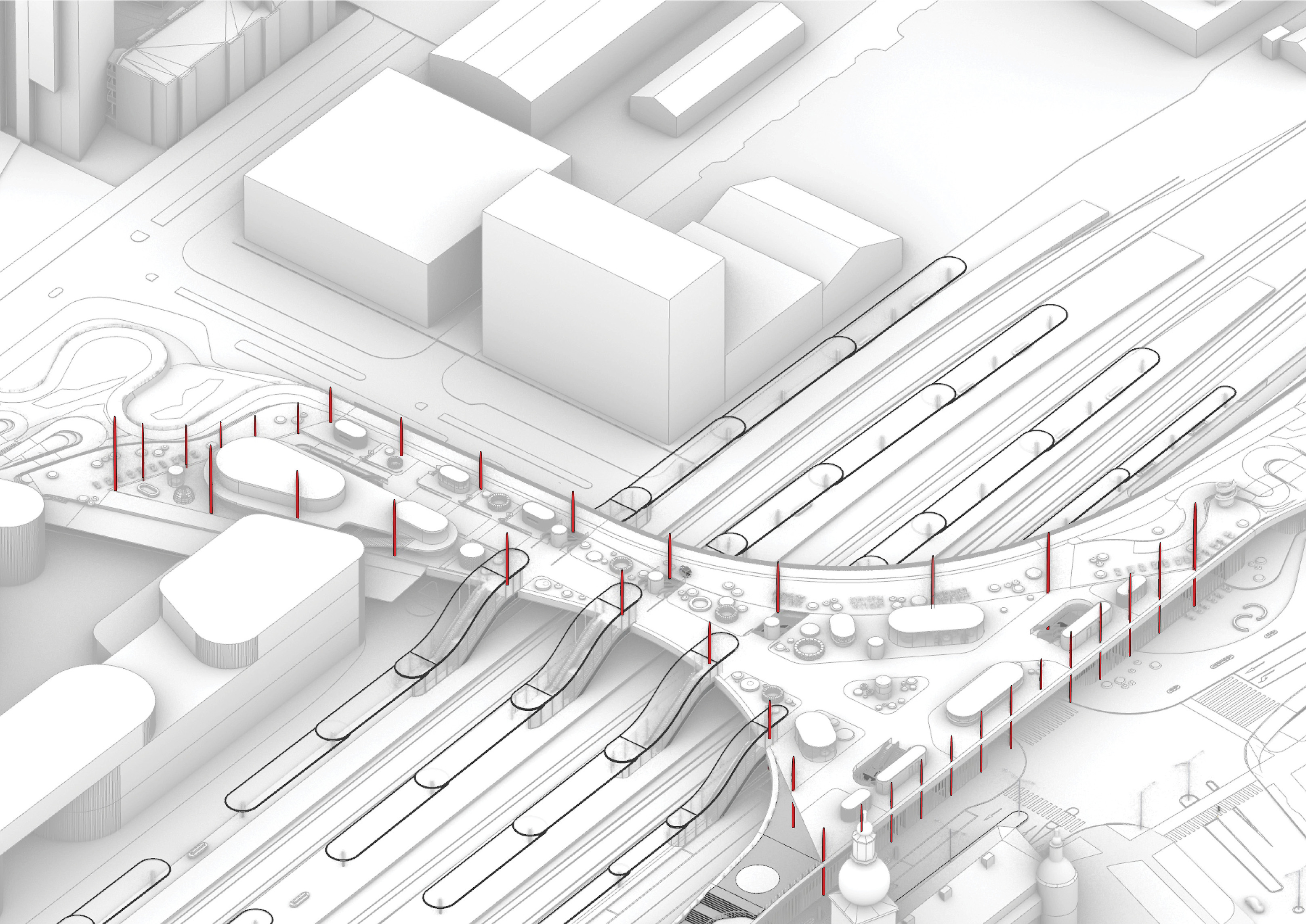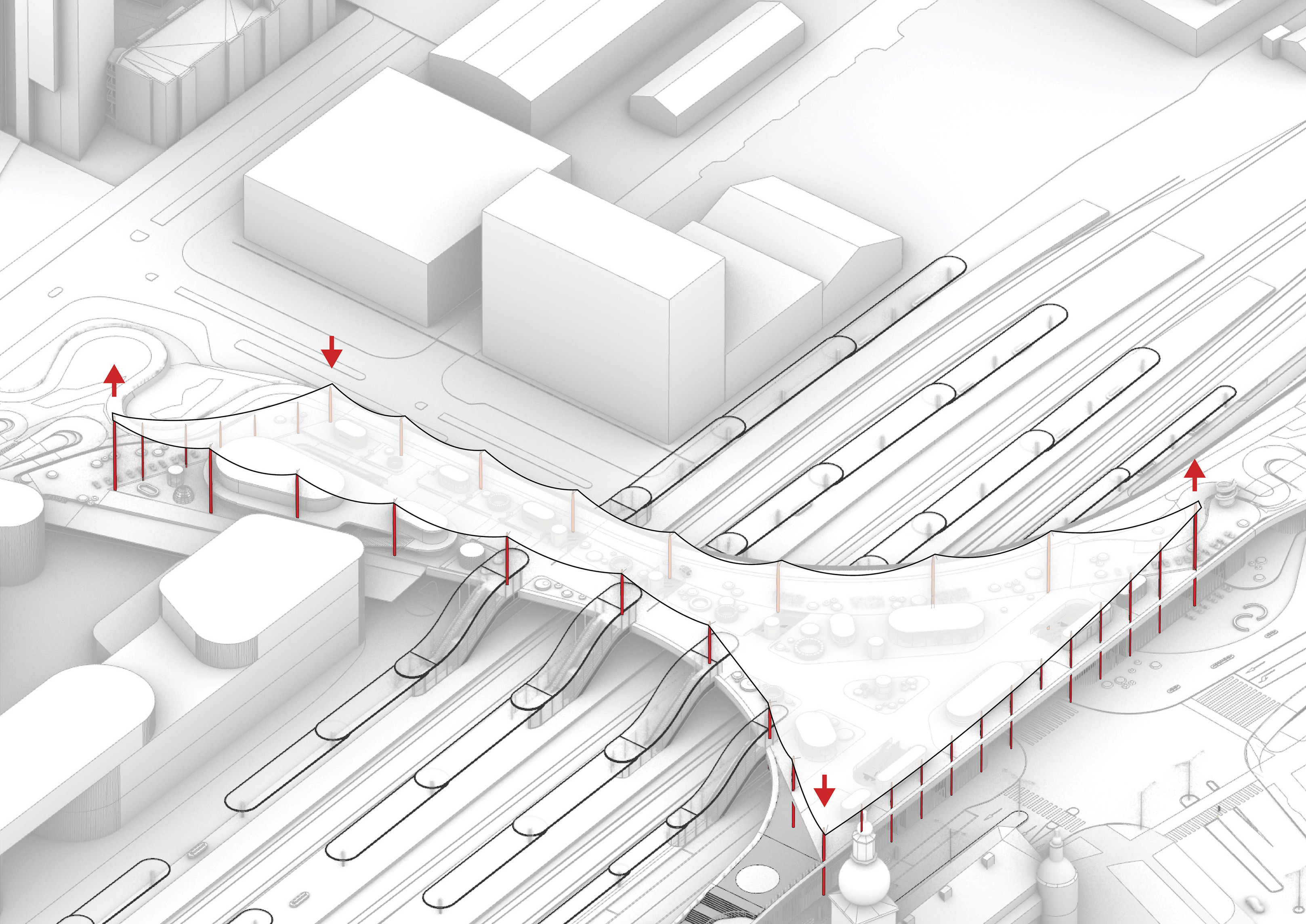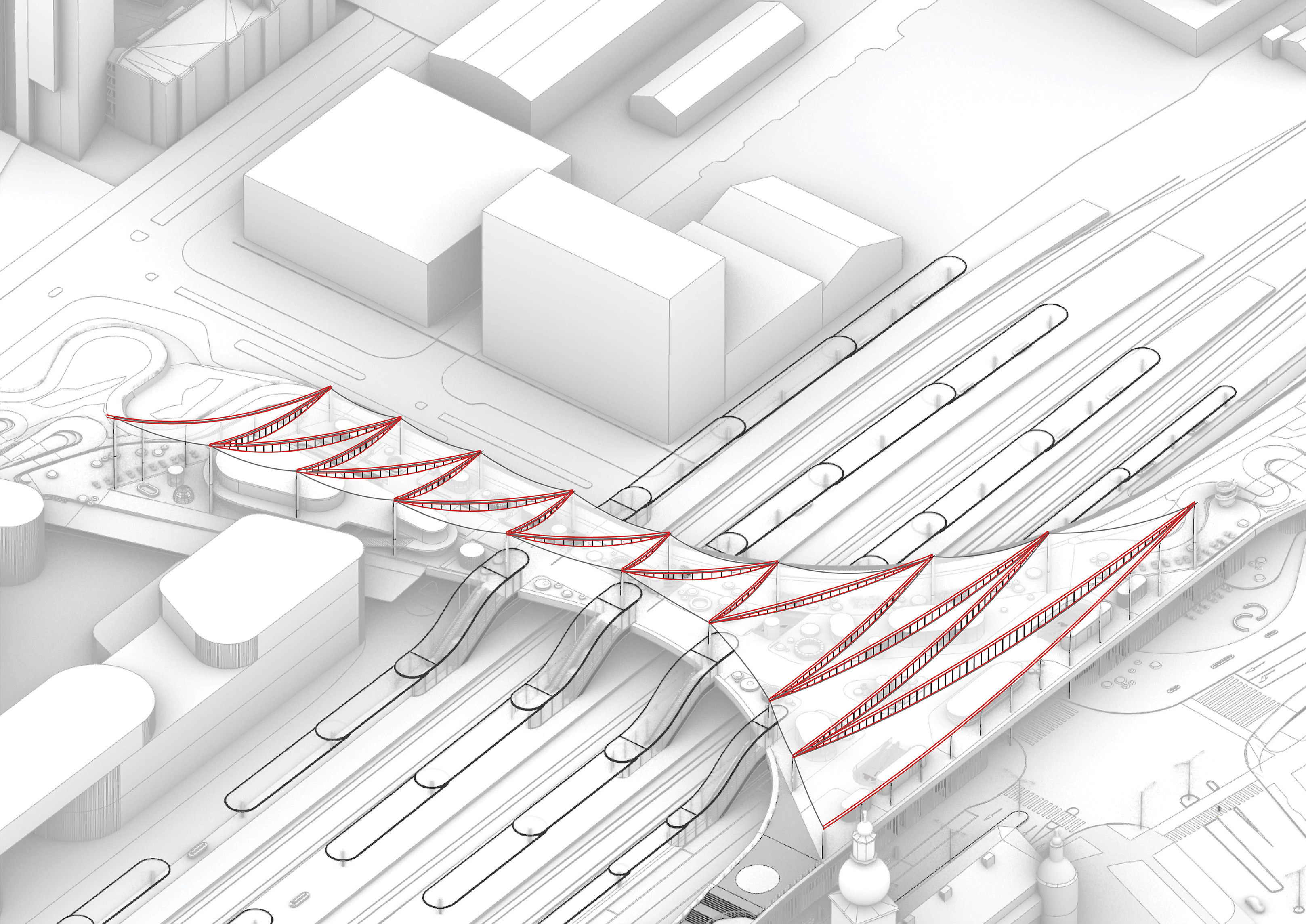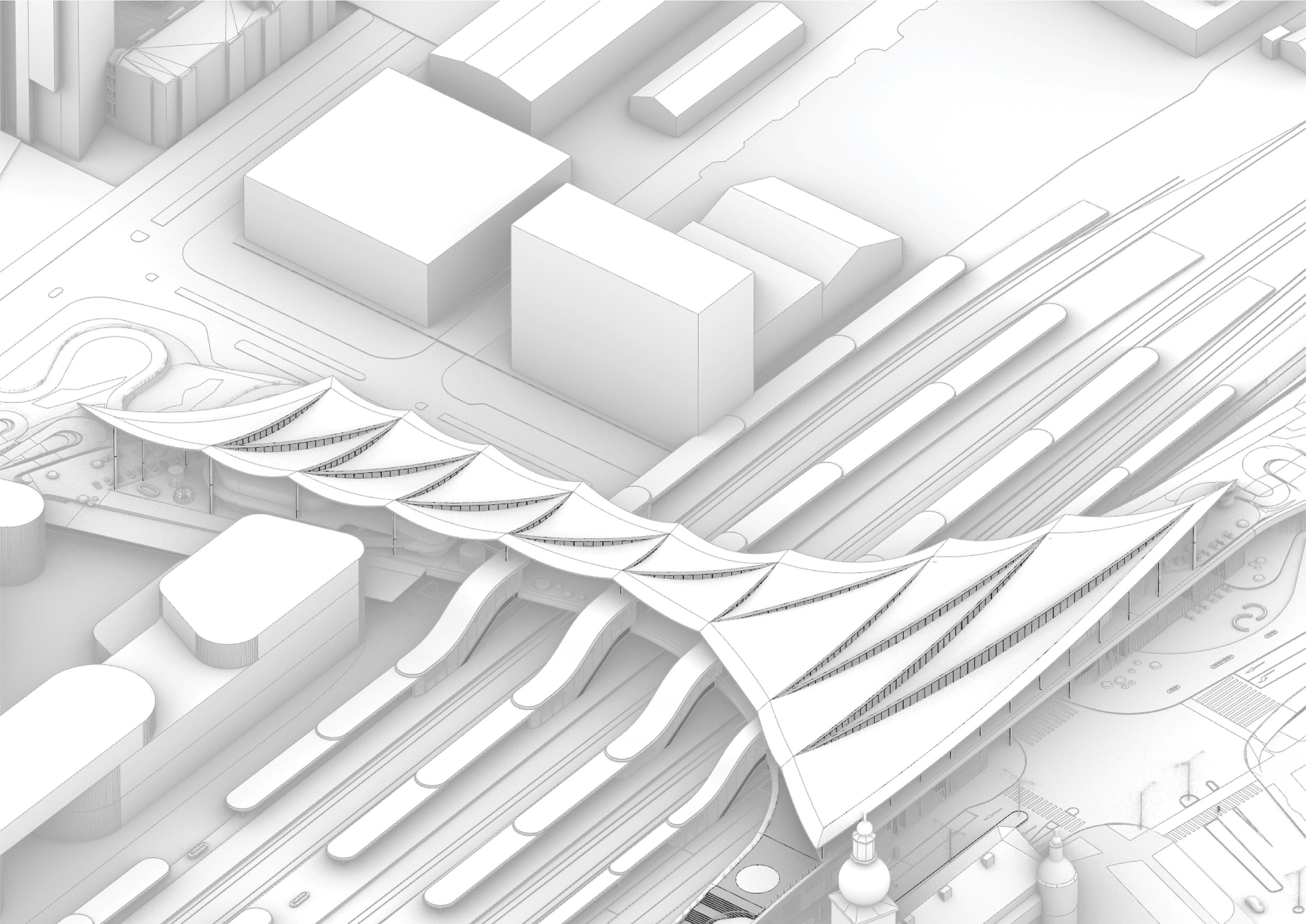STATUS
IN DESIGN
VÄSTERAS, SWEDEN
CLIENT
Västerås Municipality
TYPOLOGY
Infrastructure
SIZE M2/FT2
16,963 / 182,588
STATUS
IN DESIGN
SHARE
Västerås Travel Center is a new infrastructural hub in the heart of one of Sweden’s largest cities. The building is expected to open in 2025 and seeks to bring the entire city’s infrastructure together under one roof.
BIG’s design has evolved over the years to ensure the best possible solutions in function, program, sustainability, and future security. Designed as a piece of social infrastructure, the travel center is shaped for the flow of people and public life. The building celebrates movement and creates a welcoming, warm and transparent mobility hub that will become an important social and economic node redefining the city’s infrastructure and landscape.
The raised corners of the Travel Center clearly mark the most important entries in relationship to the city’s flows. The roof answers dilemmas caused by the city’s ongoing development by connecting the transportation hub’s complex programs in a clearly readable unit.
Placing the lowest point of the roof towards the middle over the center points of the bridges, the roof follows the Travel Center’s program, and does not encroach on any commercial surfaces. The roof shape meets the sweeping gestures of the ramps in low nodes over the track area, and a dramatic pull is created between the city center and Lake Mälaren.
The landscape unites across the railway and is shaped by flow. The fast flow that takes the traveler directly to their destination, the slow flow that takes the visitor on a journey of discovery and a coffee break, the bicycle flow that swings slightly in the landscape, and a winding flow that provides accessibility for everyone. On top of this landscape an environment of commercial surfaces with street furniture and protected zones gives an organic and soft expression. Residents will be able to cross the railroad tracks and travel between the districts all year round and around the clock via the separated pedestrian and bicycle passage. Ground heating and lighting will be available for cold and dark periods.
Along with the bus terminal and integrated platform area in Resecentrum is a bright, modern bicycle garage, travel services, commercial areas, restaurants, offices, event areas, and exhibition spaces. The resort’s facilities also include outdoor bicycle parking, taxi zones, areas for boarding and disembarking, as well as short-term parking.
The new bus square will double the size of the current bus terminal and have 37 stops for buses in public transport. The commercial bus traffic will be moved to the south side of the tracks.
“We have designed the defining feature of Västerås Travel Center, the floating roof, as a rolling, light stratus cloud that shelters the travelers and landscape. Continuous in plan but changing in section, the roof opens the Travel Center to both the city side and the harbor side at the same time as it gathers around the traveler, serving to protect, collect and invite visitors. Västerås travel center is designed based on flow. Flow for public transportation and for the traveler, but also for the as shortcuts for the citizens of Vesterås. The travel center connects the city side with Mälarporten and Mälaren by lifting the city floor over the railway tracks. Vasaparken's green urban space is expanded and leads pedestrian and bicycle lanes up and over the tracks and connects the center with Hamnparken and Mälaren.”
Terraces surrounding the Travel Center create natural connections to Vasaparken and Hamnparken, and meeting places that act as extensions of the city’s rooms, floors, parks, and streets. Visitors and locals can enjoy lookout points, meeting places, hang out spots, playful edges for skating, resting in the sun, WiFi zones, and seating to observe the city.
The boundary between inside and outside is blurred by the building’s glazed and long curved facades, ensuring light and openness at the building’s edges, while active facades increase the feeling of security. Biophilic spaces carry the landscape indoors, where travelers can move under a protective roof with platform connections down to the trains.
To let light in and circulate air, the ceiling has been sliced with a zigzag line, from one side to the other. This load-bearing design element extends the roof between the perimeter of the façade, creating an indoor landscape free of pillars for commercial programs to be designed without obstacles.
The design of the new Travel Center will work with the building’s integrated solar cell system on the vast roof surface to harvest the sun’s energy, with the capability of covering nearly 70% of the project’s energy demand. The indoor climate will be managed through natural ventilation, and heating through underfloor heating, and the potential use of floor cooling and rainwater recycling. Conditions will be improved for public transport in the city, providing a natural flow for bicycles and pedestrians, as well as passengers switching between modes of transport. These benefits along with charging stations and places for micro-mobility will reduce citizen’s reliance on cars.
Bjarke Ingels David Zahle Andreas Klok Pedersen Marius Tromholt-Richter Rasam Aminzadeh Allen Shakir Aileen Koh Anders Bruntse Anders Holden Deleuran Andre Enrico Cassettari Zanolla Anke Kristina Schramm Augusto Lavieri Zamperlini Dalma Ujvari Eivor Vik Federica Fogazzi Teodor Cristian Fratila Frederik Lyng Geetika Bhutani Geoffrey Eberle Ipek Akin Jan Magasanik Jesper Kanstrup Petersen Johan Bergström Kamilla Heskje Laura Wätte Laurine Louisette Marie Alard Linnea Lujak Luca Pileri Malcolm Rondell Galang Margarida Fino Jerónimo Margarita Nutfulina Marie Lançon Martino Hutz Matthew Oravec Moa Carlsson Ovidiu Munteanu Peter Høgenhaven Raphael Ciriani Rihards Dzelme Sofia Fors Adolfsson Tomas Karl Minör Tore Banke Tyrone Cobcroft Vladislav Saprunenko Weronika Bogal Yunus Alperen Basak Yu Xun Zhang Gül Ertekin Natasha Lykke Lademann Østergaard Camila Luise de Andrade Stadler Edmond Lakatos Franck Fdida Giedrius Mamavicius Gwendoline Eveillard Ioana Fartadi Scurtu Magnus Garvoll Megan Fiona Cumming Nicolas Millot Oscar Abrahamsson Perle van de Wyngaert Shin Saeki Ola Sobczyk Su Myat Nge Nge Dobrochna Anna Klimczak Ondrej Slunecko Malgorzata Mutkowska Victoria Prillo
Tyrens
Kragh & Berglund
Rambøll
Sweco Archtects AB
VAP
AFRY
Brandprojektering AB
Kadesjös
PQ Projektledning AB
Structor Riskbyrån AB
WSP
